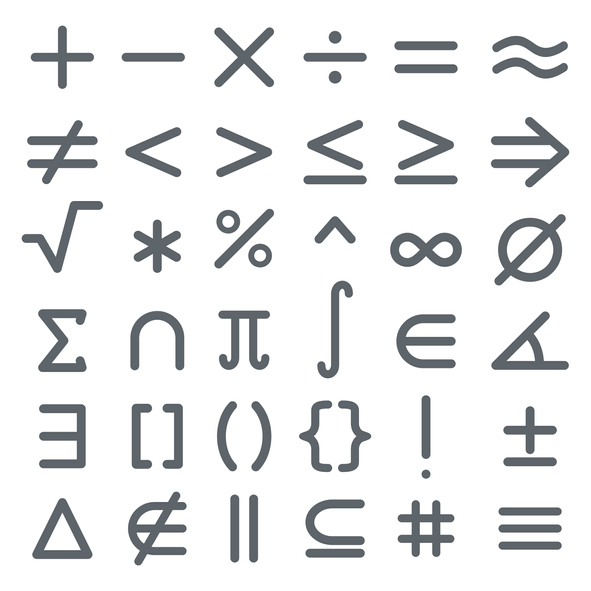Unlocking Unicode Symbol Input on MacOS
If you’re using MacOS, enabling Unicode symbol input is straightforward. Here’s a step-by-step guide to set it up:
- Open System Preferences: Navigate to your Mac’s “System Preferences.”
- Go to Keyboard Settings: Search for “Keyboard,” then edit “Input Sources”
- Add Unicode Hex Input: Click the “+” button to add a new input source. Scroll down and select “Unicode Hex Input” from the list.
Once enabled, you can switch to the Unicode Hex Input keyboard whenever needed. To input a Unicode symbol:
Hold down the Option key (sometimes labeled as Alt) on your keyboard.
Type the Unicode code corresponding to the character you want.
For example, to type the symbol ℝ (the set of real numbers), hold Option and type 211D. The symbol will instantly appear in your document.
Speeding Up Symbol Entry with Karabiner Elements
For frequent symbol input, you can streamline the process further by remapping keys using a tool like Karabiner Elements. For instance, you can remap the Enter key on your numeric keypad to function as Alt (or Option) for faster access to Unicode symbol codes. This setup is ideal for tasks like taking math notes or writing in scripts that require occasional special characters.
Unicode vs. LaTeX: Why Unicode Symbols Work for Quick Input
LaTeX is the go-to formatting language for academic and technical documents, especially for inserting complex mathematical equations and symbols. However, it requires compiling your code into a formatted output like a PDF, which might feel cumbersome for quick note-taking or casual writing.
By contrast, Unicode symbols are directly inserted into your document, making them faster and more intuitive for on-the-fly use. For someone who doesn’t need the full power of LaTeX, typing Unicode codes is a simple and efficient alternative.
Why You Should Consider Unicode for Everyday Use
Whether you’re jotting down notes, crafting a document, or experimenting with special characters, Unicode symbol input provides flexibility and speed. You don’t need to disrupt your workflow or switch between input languages—you simply hold a key and type the code. Once set up, it’s a seamless way to expand your keyboard’s capabilities beyond its printed keys.
If you’re using MacOS, take a few minutes to enable Unicode Hex Input and experiment with the endless possibilities it unlocks. With a little customization, like remapping keys, you’ll find that inserting symbols, mathematical notations, or unique characters has never been easier.
By optimizing your keyboard setup with Unicode, you gain access to a world of symbols and scripts—perfect for anyone who needs occasional character diversity without diving into more complex tools like LaTeX.
List of common mathematical Unicode symbols (in no particular order):
I have a list below of the symbols I use for my mathematics studies. I’ll keep updating this page if I need new symbols for my studies. How I use it is by doing a English word search that jumps to the listed symbol.
Format: (unicode code) (output symbol) (English word for symbol)
Computational:
2716 ✖ multiplication
00f7 ÷ division
221a √ sqrt
221b ∛ sqrt³
221c ∜ sqrt⁴
222b ∫ integral
222c ∬ integral double
222d ∭ integral triple
27cc ⟌ long division
2032 ′ first derivative
2033 ″ second derivative
2034 ‴ third derivative
2202 ∂ partial derivative
2211 ∑ sum
00ba º degree
2260 ≠ not equal
2261 ≡ if and only if, identical
2262 ≢ not identical
2264 ≤ less than or equal to
2265 ≥ greater than or equal to
2270 ≰ not less than or equal to
2271 ≱ greater than or equal to
2248 ≈ roughly is equal to
Greek letters:
2206 ∆ delta
03b8 θ theta- used for angles
03a6 Φ phi
03b6 ζ small letter zeta
03b8 Θ Capital theta
03c4 τ tau
Sets:
211d ℝ real
2115 ℕ natural
2124 ℤ integers
211a ℚ rational
221e ∞ infinity
2200 ∀ for all
2205 ∅ null-set
222a ∪ union
2229 ∩ intersection
2203 ∃ there exists
2208 ∈ element of
220b ∋ contains as a member
Constants:
212f ℯ euler
2148 ⅈ imaginary
2107 ℇ euler’s constant
03c0 π pi
Geometric:
223f ∿ sin θ
27c2 ⟂ perpendicular
2220 ∠ angle
299c ⦜ right angle
2221 ∡ angle opening counter-clockwise
29aa ⦪ angle opening clockwise
22bf ⊿ right triangle
27c0 ⟀ three dimensions
Super and Sub Letters and Symbols:
1d43 ᵃ super a
1d47 ᵇ super b
1d9c ᶜ super c
1d48 ᵈ super d
1d49 ᵉ super e
1da0 ᶠ super f
1d4d ᵍ super g
02b0 ʰ super h
2071 ⁱ super i
02b2 ʲ super j
1d4f ᵏ super k
02e1 ˡ super l
1d50 ᵐ super m
207f ⁿ super n
1d56 ᵖ super p
02b3 ʳ super r
02e2 ˢ super s
1d57 ᵗ super t
1d58 ᵘ super u
02b7 ʷ super w
02e3 ʳ super r
02b8 ʸ super y
1dbb ᶻ super z
207a ⁺ super plus
207b ⁻ super minus
2070 ⁰ super 0
00b9 ¹ super 1
00b2 ² super 2
00b3 ³ super 3
2074 ⁴ super 4
2075 ⁵ super 5
2076 ⁶ super 6
2077 ⁷ super 7
2078 ⁸ super 8
2079 ⁹ super 9
2090 ₐ sub a
2091 ₑ sub b
1d62 ᵢ sub i
2092 ₒ sub o
1d63 ᵣ sub r
1d54 ᵤ sub u
1d65 ᵥ sub v
2093 ₓ sub x
1d67 ᵧ sub y
2080 ₀ sub 0
2081 ₁ sub 1
2082 ₂ sub 2
2083 ₃ sub 3
2084 ₄ sub 4
2085 ₅ sub 5
2086 ₆ sub 6
2087 ₇ sub 7
2088 ₈ sub 8
2089 ₉ sub 9
